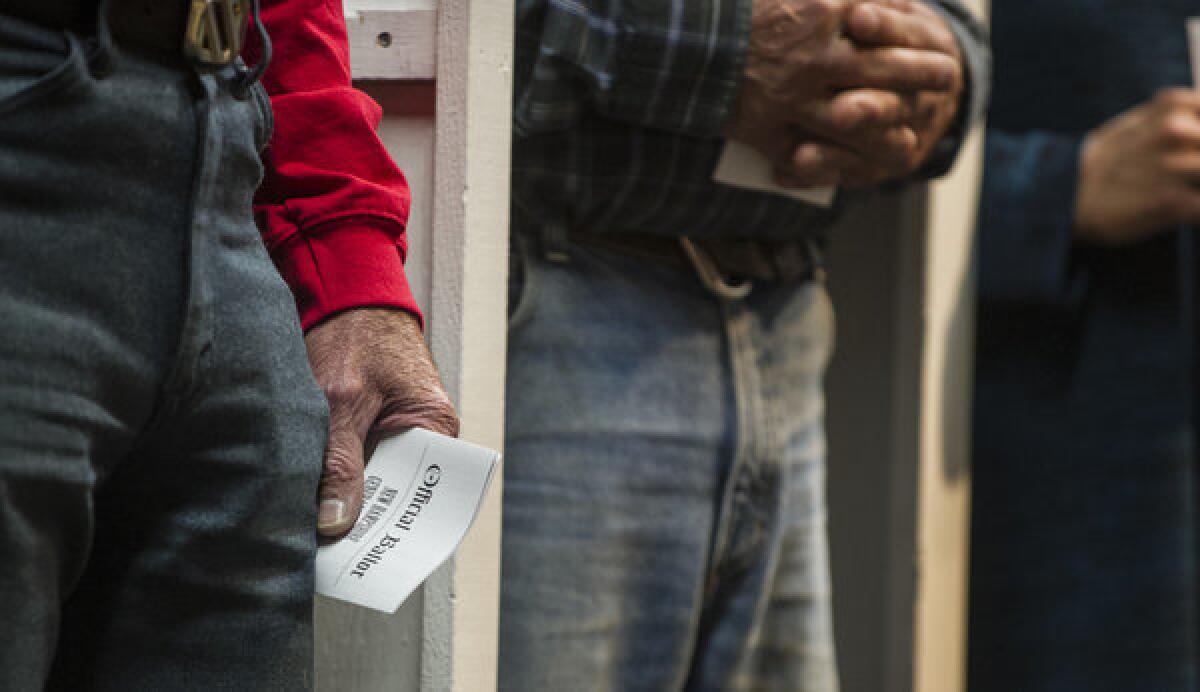Election 2012: What to watch for as the polls close

- Share via
Like a giant wave, the presidential election returns will be rolling in east to west on Tuesday night, starting at 7 p.m. local time when the polls close in Virginia, as well as five other states. It will be hours — maybe even days — before the winners are known.
But experts will immediately start poring over the results make educated guesses, based on preliminary returns and past voting patterns.
If, for instance, a candidate runs better — or considerably worse — than expected in certain parts of a state, that could give an early sign of which way a state is headed. Here’s how armchair analysts can play along at home. (All times are Pacific.)
Photos: America goes to the polls
4 p.m. Virginia is the state to watch. A loss here would be a huge blow for Republican nominee Mitt Romney, who is counting on the state’s 13 electoral votes as part of his path to the 270 it takes to win the White House. He needs to run up big margins in Hanover County (the Richmond suburbs), Campbell County (home to many religious conservatives) and the rural parts of the state.
President Obama’s base is Richmond, with its large black population, and he needs to win big in the Washington suburbs of Arlington and Fairfax County. If either candidate underperforms in those areas, he’s in trouble.
4:30 p.m. Polls close in three states, including Ohio and North Carolina. An Obama win in North Carolina could mean he would be headed for an electoral college blowout. But the state to watch is Ohio, which has emerged as the keystone of the campaign.
No Republican has ever won the White House without Ohio, and Romney desperately needs its 18 electoral votes, unless he can pull off a huge upset in Pennsylvania. Obama should run up big numbers in Cuyahoga County (Cleveland), and Romney will likely win big in the suburbs outside Cincinnati and parts of rural Ohio. The place to watch is central Ohio, centered around the Columbus media market. If Obama wins there, he will probably win the state and, quite possibly, the White House along with it.
INTERACTIVE: Battleground states map
5 p.m. The polls close in 16 states and the District of Columbia. Two of them are battlegrounds, Florida and New Hampshire. Florida, as most remember, was the decider after six tortuous weeks in 2000, and it remains preeminent among swing states. It has by far the biggest cache of electoral votes -- 29 -- among this year’s battleground states.
Simply put, if Romney loses Florida, it’s virtually impossible to see how he wins the White House. He needs a big vote in Escambia County in the state’s conservative “Redneck Riviera” (it’s a military stronghold as well) and Collier County, home to Naples and a large population of Midwestern retirees. The president needs a big vote in southeastern Florida, especially Miami-Dade, Broward and Palm Beach counties. As always, the fight will likely come down to the nine counties along the Interstate 4 corridor between Orlando and Tampa, including Orange, Polk, Hillsborough, Pasco and Pinellas counties
In New Hampshire, Romney needs to win big in the two largest counties, Hillsborough (which includes Manchester and surrounding communities, and Nashua) and Rockingham. Both counties border Massachusetts, and voters there are quite familiar with Romney from his years as the Bay State’s governor. Obama needs a strong showing in the city of Manchester, which traditionally leans Democratic, to pick up the state’s four electoral votes.
VIDEO: The best, and worst, of the year’s political ads
6 p.m. Polls close in 14 states, including Wisconsin and Colorado. No Republican has won Wisconsin since 1984, and a victory here for Romney and his running mate, Rep. Paul D. Ryan of Janesville, would give them 10 electoral votes and signal trouble for Obama.
The president should win by substantial margins in Dane County, home to the University of Wisconsin, as well as the city of Milwaukee. Romney’s strength is the Milwaukee suburbs. The key will be the northern part of the state. If Romney is up by 10 or more points in the Fox Valley, which includes Oshkosh and Appleton, that’s good for the Republicans. If Obama can hold down Romney’s margin, he should carry the state.
In Colorado, Romney should run strongly in the counties of Weld (Greeley), Mesa (Grand Junction), El Paso (Colorado Springs, home of the Christian organization Focus on the Family) and Douglas. (The latter is midway between Colorado Springs and Denver.) Obama is expected to run up big vote totals in Denver, Pueblo (which has a sizable Latino population) and Boulder, home to the University of Colorado and its large student and liberal populations.
LIVE: Presidential election results
The race will likely come down to Jefferson County, a Denver suburb with large numbers of independent and fiscally conservative, socially moderate voters.
7 p.m. Polls close in four states, including Nevada — a one-time battleground that seems to have settled in Obama’s column — and Iowa, the last of the true tossups.
Western Iowa, especially the area around Sioux City, is the conservative heartland, and Romney should clean up. For Obama, the challenge is running up the numbers in and around Des Moines. the area around the University of Iowa in Iowa City, and Cedar Rapids, Davenport, Waterloo and Dubuque. The winner gets Iowa’s six electoral votes, which could be crucial if the results in the electoral college are tight.
Follow Politics Now on Twitter and Facebook
Twitter: @markzbarabak
More to Read
Get the L.A. Times Politics newsletter
Deeply reported insights into legislation, politics and policy from Sacramento, Washington and beyond. In your inbox twice per week.
You may occasionally receive promotional content from the Los Angeles Times.











